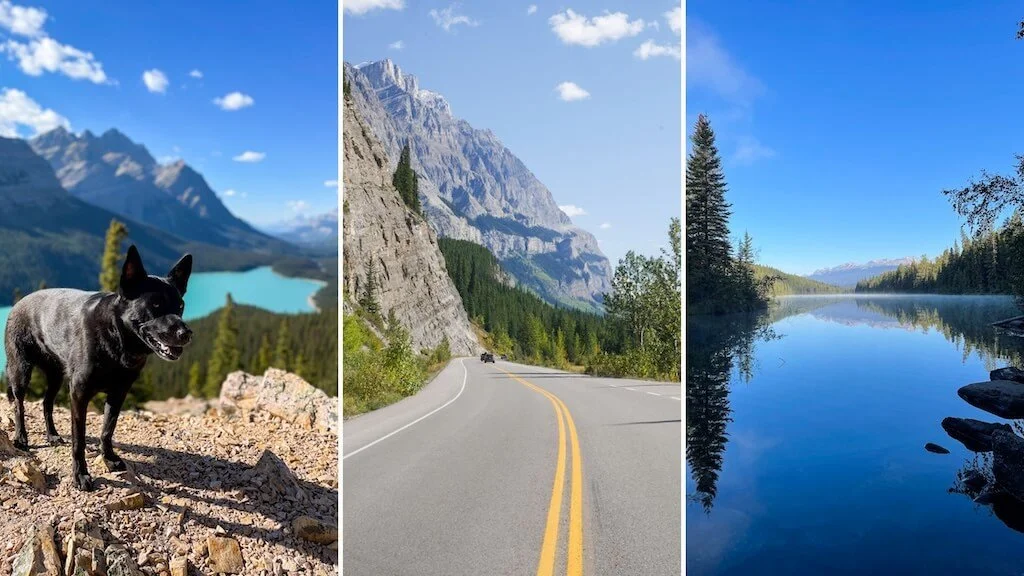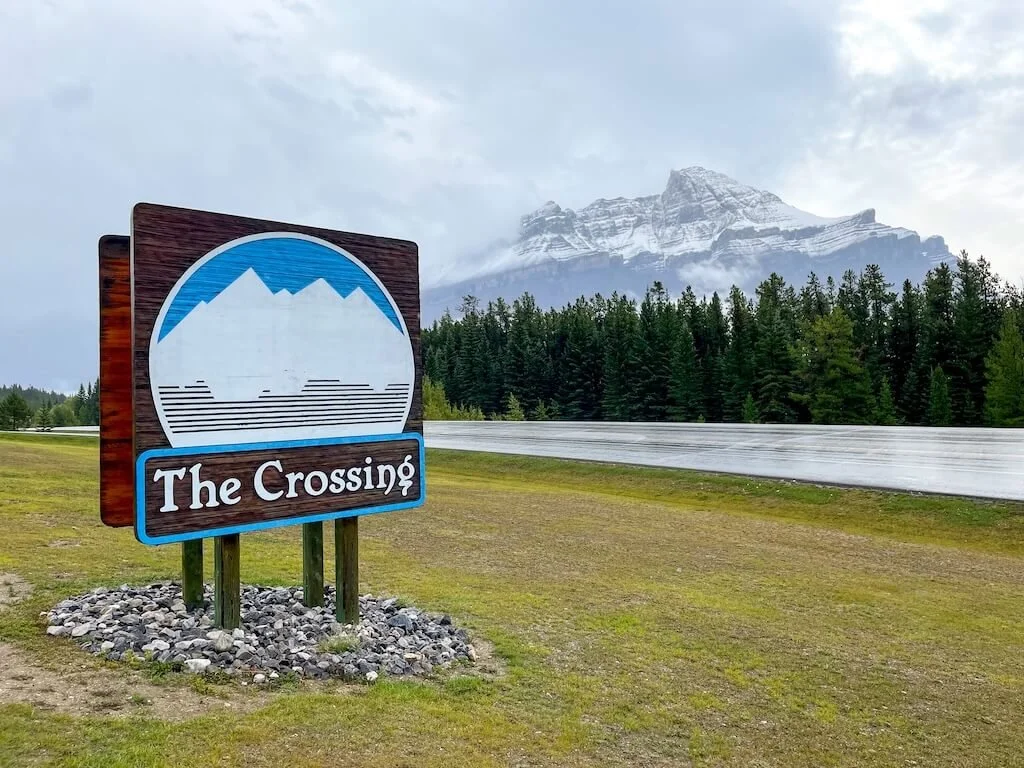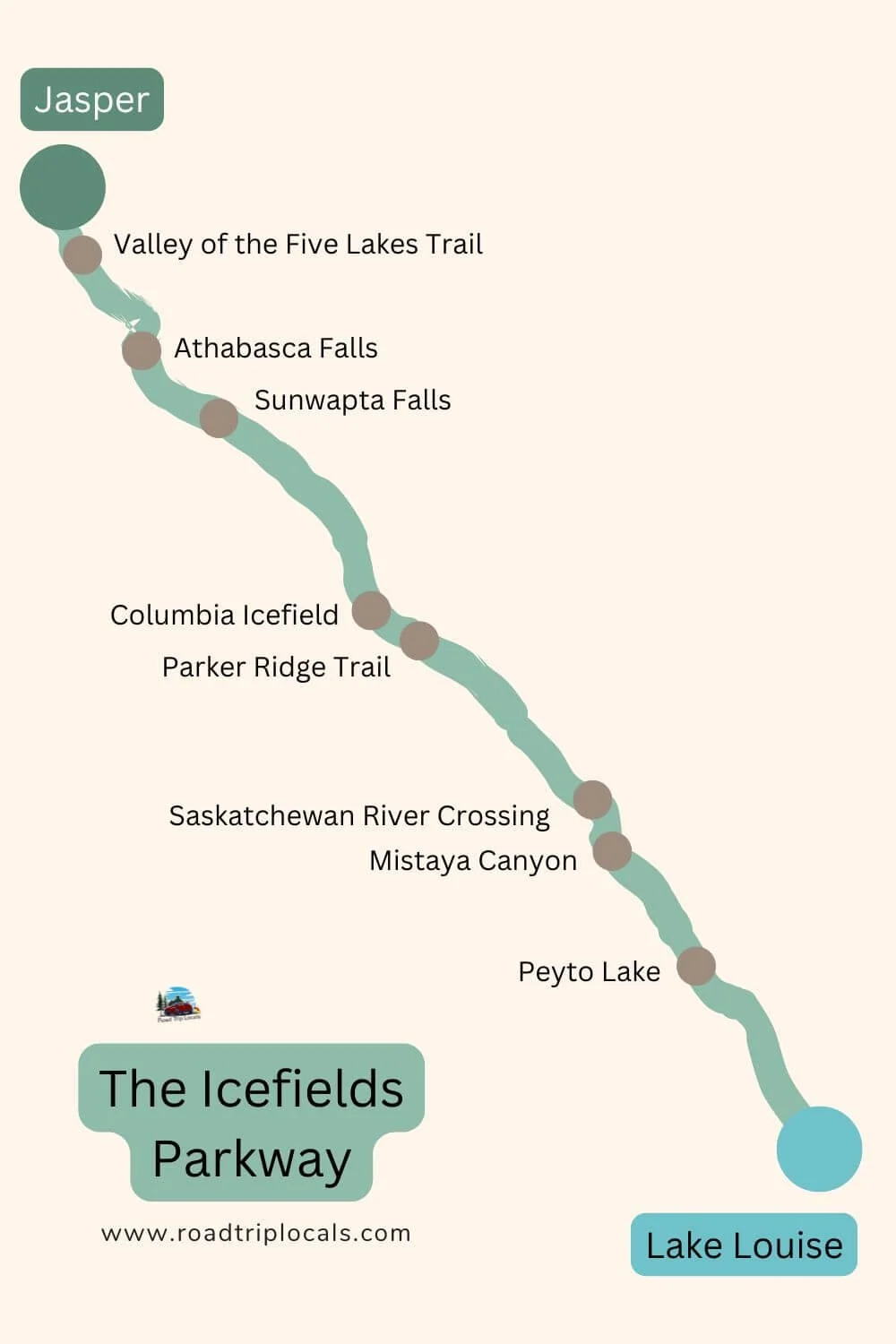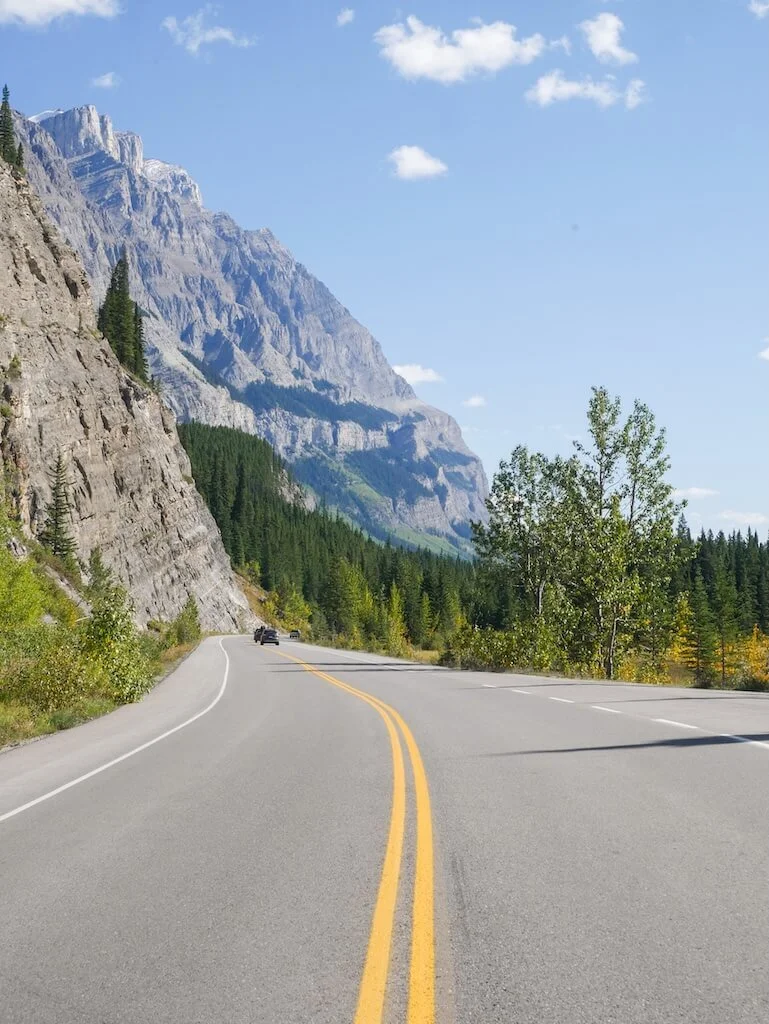Beginner’s Guide to Driving the Icefields Parkway
The Icefields Parkway is a 144-mile drive through the Canadian Rockies, connecting Lake Louise in Banff National Park to Jasper in Jasper National Park. Along the way, you’ll see glaciers, turquoise lakes, waterfalls, and mountain peaks, with plenty of wildlife tucked into the trees in between. This is a drive meant for stopping often and taking in the scenery, whether you have a few hours or a few days to explore. The Icefields Parkway is truly one of the most beautiful drives in the world!
Where is the Icefields Parkway?
The Icefields Parkway runs between Lake Louise and Jasper, in Alberta, Canada. It sits entirely within protected parklands (Banff and Jasper National Parks) and follows the Continental Divide through the Rocky Mountains.
There are two main entrances:
South end: Lake Louise, near the Trans-Canada Highway (Highway 1)
North end: Jasper, accessible via Highway 16 (the Yellowhead Highway)
When to Go: Seasonal Guide for the Icefields Parkway
Spring (Late May to mid-June): Wildlife & Snowy Peaks
Excellent time for wildlife sightings as animals come closer to the roads to forage.
Stunning snow-capped peaks with green valley floors.
Waterfalls at full flow from snowmelt.
Some trails may still have snow coverage; higher-elevation hikes may be closed.
Summer (Late June to early September): Full Access & Peak Hiking
All major hiking trails and scenic viewpoints are open and this is peak season for hikes like Wilcox Pass, Parker Ridge, and the Plain of Six Glaciers.
Glacier-fed lakes like Peyto and Bow are at peak color in July and August and wildflowers peak in late July.
Long daylight hours (sunset after 9pm) means more time for sightseeing!
Busiest and most crowded season.
Fall (September to early October): Larch Season
The larch trees (the golden pine-looking trees) change color in late September, especially near Banff, Lake Louise, and the Kananaskis. The hikes at Larch Valley or Sentinel Pass are stunning this time of year, but some higher-elevation trails and facilities start to close by mid-October.
Cooler temps mean fewer crowds but still great driving and photography conditions.
The Jasper Dark Sky Festival is a stargazing festival held annually in October in one of the world’s largest dark sky preserves.
Winter (Late October to April): Snowy & Quiet
Most of the Icefields Parkway is still open for driving year-round but can be very icy and remote. Only experienced winter drivers should attempt it.
Best for cross-country skiing, ice climbing, and winter photography. Lake Louise becomes a winter wonderland for ice skating and snowshoeing.
Synchronous Bubbles at Abraham Lake happen east of the Icefields Parkway (about 30 minutes from Saskatchewan River Crossing) between January and February.
How Long Do I Need to Drive the Icefields Parkway?
You can technically drive the Icefields Parkway in under 3 hours, but to really experience it, plan for:
One full day: Drive with photo stops and short walks to Peyto Lake, Toe of the Glacier, Mistaya Canyon, Sunwapta Falls, and Athabasca Falls
Two days: Stay overnight to add glacier tours, longer hikes (Parker Ridge and Valley of the Five Lakes Trails), and sunrise/sunset photography
Three+ days: Explore more remote hikes (Bow Summit, Cephren Lake, and Wilcox Pass) and connect with side trips in Banff, Jasper, or Yoho National Park (Emerald Lake is amazing!)
Where to Stay Along the Icefields Parkway
You can stay at either end of the route in Lake Louise or Jasper. For mid-route options, consider Glacier View Lodge (at the Columbia Icefield), Sunwapta Falls Lodge, or The Crossing Resort at Saskatchewan River Crossing.
Best Stops Along the Icefields Parkway
The stops below are listed in driving order from Lake Louise to Jasper. We’ve marked a few of our absolute favorites with an asterisk (*), but honestly, they’re all worth seeing! And of course, plan plenty of time to explore Lake Louise and Jasper themselves. Both offer even more to do beyond this drive.
Herbert Lake: Quick early stop just minutes after starting; great morning reflection spot.
Bow Lake & Bow Glacier Falls: Beautiful roadside lake with the option for a moderate hike to Bow Glacier Falls.
Peyto Lake*: Famous dog/wolf-head shaped lake; short walk to an amazing viewpoint! Especially stunning on clear mornings.
Chephren Lake*: If you’re looking for a peaceful hike through the woods, this trail leads to stunning lake views framed by towering peaks.
Waterfowl Lakes: Easy pullout with gorgeous alpine lake views.
Mistaya Canyon*: Quick, easy walk to a dramatic canyon carved by glacial melt.
Saskatchewan River Crossing: Scenic junction and good rest stop. Also the only place to get fuel on the Icefields Parkway.
The Big Bend Viewpoint: A sweeping hairpin curve in the road with dramatic views of the surrounding mountains and glaciers.
Parker Ridge Trail*: Short hike with massive glacier views (summer only). A locals favorite!
Glacier View Lodge & Columbia Icefield / Athabasca Glacier*: Glacier tours or short hikes to the glacier’s edge (consider Toe of the Athabasca Glacier).
Glacier Skywalk: Glass-bottomed walkway overlooking Sunwapta Valley.
Wilcox Pass: One of the best hikes for panoramic glacier views.
Tangle Falls: Beautiful roadside waterfall; no hiking required.
Sunwapta Falls: Impressive waterfall with short walking paths.
Athabasca Falls*: Powerful falls with several easy viewing platforms.
Valley of the Five Lakes*: A fantastic loop trail with several beautiful small lakes, perfect for an easy hike with lots of variety.
What to Know Before You Go
Fuel up before you leave. There are no gas stations between Lake Louise and Jasper, except seasonal fuel at Saskatchewan Crossing.
Bring food and snacks. Limited dining options exist along the route.
No cell service. Download maps and trail guides ahead of time.
Parks Canada Discovery Pass is required for both Banff and Jasper.
Weather changes fast. Bring layers, even in summer!
Start early or stay late. Sunrise and sunset are magical on the Parkway, and much less crowded.
Which direction should I drive the Icefields Parkway?
We recommend driving southbound (from Jasper to Lake Louise) for the most dramatic views. Glaciers are on the right side of the road when heading south, and the perspective often gives you that classic “driving into the mountains” feeling, with snow-capped peaks rising straight ahead.
That said, visibility makes a big difference. When we drove northbound, we had overcast skies and low clouds that hid many of the peaks. But on our southbound drive, the sun came out and completely changed the feel of the road, revealing just how massive and awe-inspiring these mountains really are.
💡 RTL Tip: If you're driving on a cloudy day, don’t just stay in the car. Get out and explore on foot. Many of the most beautiful sights are even better when you're out on a trail or walking path. That’s one of the best things about the Icefields Parkway… you’re never far from something spectacular!
Drive Times & Logistics
Here’s a quick look at the drive times between major stops on the Icefields Parkway:
Lake Louise to Peyto Lake: 35 minutes (44 km)
Peyto Lake to Columbia Icefield Centre: 1 hour (80 km)
Columbia Icefield Centre to Sunwapta Falls: 45 minutes (50 km)
Sunwapta Falls to Athabasca Falls: 20 minutes (25 km)
Athabasca Falls to Jasper: 25 minutes (32 km)
While the total drive time between Lake Louise and Jasper is just over 3 hours without stops, we strongly recommend planning at least 5 to 8 hours (or better yet, a full day or two!) to enjoy the route properly.
There are dozens of incredible viewpoints, short walks, and waterfall stops along the way, plus opportunities for wildlife sightings and longer hikes. The road itself is stunning, but what really makes the Icefields Parkway unforgettable is how often you’ll want to pull over, stretch your legs, and take it all in.
Peyto Lake
Icefields Parkway FAQ
Q: Where can I find an Icefields Parkway map?
Visitor centers in Banff, Lake Louise, and Jasper offer free printed maps that show all major stops, hikes, and services along the route. Parks Canada also offers downloadable maps online, which are great to save to your phone ahead of time since cell service is very limited along the Parkway.
Q: What’s the weather like on the Icefields Parkway?
Summer brings warm days (highs around 60–70°F / 17-20°C) and cool nights, but weather can shift quickly, even in July. Spring and fall have chilly mornings, occasional snow flurries, and cooler daytime highs. Winter driving (late October through April) can be hazardous due to snow, ice, and avalanche risks. Always check conditions before driving.
Q: Can I camp along the Icefields Parkway?
Yes! There are 11 seasonal campgrounds along the Icefields Parkway, including Wilcox Creek, Waterfowl Lakes, Rampart Creek, Silverhorn Creek, and Honeymoon Lake. Many are first-come, first-served during peak summer, though a few (including Silverhorn Creek and Rampart Creek) can be reserved in advance through Parks Canada.
Q: How are road conditions?
The Parkway is paved and well-maintained in summer but can experience closures for snow, ice, or avalanche danger during shoulder seasons and winter. Check Parks Canada for up-to-date road conditions before your trip, particularly if traveling before late June or after early October.
Q: What is the Glacier Skywalk?
The Glacier Skywalk is a glass-bottomed observation platform that extends out over the Sunwapta Valley, offering panoramic views of the surrounding mountains and glaciers. It’s located near the Columbia Icefield Discovery Centre and is open seasonally from late spring through early fall.
Q: How much wildlife will I see?
This is one of our favorite questions to ask park rangers when we travel. At the Yoho Visitor Centre, rangers told us that spring is often the best time to spot wildlife near the road, as bears, elk, mountain goats, and bighorn sheep come down to lower elevations in search of fresh food. Wildlife sightings are possible year-round, but always keep a safe distance, never feed wild animals, and carry bear spray if you plan to hike.
Q: Is this road trip good for kids and families?
Yes! The Icefields Parkway is very family-friendly, with lots of short walks, easy viewpoints, picnic areas, and safe pullouts. Many hikes, like Mistaya Canyon and Athabasca Falls, are short and accessible for kids.
Q: Do I need a Parks Canada pass?
Yes, a Parks Canada Discovery Pass or valid entry pass for Banff and Jasper National Parks is required to drive the Icefields Parkway. You can purchase passes online or at park gates.
Q: Is the Icefields Parkway open year-round?
Technically yes, but from late October through April, winter driving conditions can be extreme, with limited services and possible road closures for avalanches or snowstorms. Summer (late June to early October) is the safest and most reliable window for full access.
Q: Where can I get gas or food along the way?
We highly recommend filling your tank in Lake Louise or Jasper before starting. The only gas station on the Parkway itself is at Saskatchewan River Crossing (open seasonally). Food options are also limited—available at Columbia Icefield Discovery Centre, Saskatchewan Crossing, and a few seasonal lodges, but it’s smart to pack snacks and drinks.
Q: Are there hiking trails directly off the road?
Absolutely! Many excellent hikes start right from roadside pullouts, including Wilcox Pass, Parker Ridge, Mistaya Canyon, Bow Glacier Falls, and the short trails around Athabasca Falls.
Q: Is the Icefields Parkway dog-friendly?
Yes! Dogs are allowed on most trails and viewpoints along the Parkway, but must be leashed at all times. Some of the best dog-friendly stops include Peyto Lake (and the trail extension to Bow Summit), Chephren Lake Trail, Parker Ridge Trail, and Valley of the Five Lakes near Jasper. Always be alert for wildlife, especially bears, and pack out any pet waste. Note that dogs are not allowed on glacier tours or inside most visitor centers.
Q: Do I need bear spray?
Yes. If you plan to hike, you should always carry bear spray, make noise on trails, and stay aware of your surroundings. (Heads up: You can’t fly with bear spray, so plan to rent or buy it once you arrive.)
Q: Is there cell service or Wi-Fi?
Cell service is extremely limited or nonexistent along most of the Parkway. Download maps, trail info, and reservations in advance. Some lodges and visitor centers offer Wi-Fi, but don’t rely on it while driving.
Q: What is Tangle Falls?
Tangle Falls is a beautiful, multi-tiered roadside waterfall located near the Columbia Icefield. You can park directly across the road and walk right up for great photos—no hiking required.
Valley of the Five Lakes
Have Time for More? Ways to Extend Your Icefields Parkway Road Trip
If you’ve got extra time, there are plenty of ways to turn your Icefields Parkway drive into an even bigger Canadian Rockies adventure:
Yoho National Park & Emerald Lake (West of Lake Louise): Just a short detour off the start of the Parkway, Yoho offers jaw-dropping scenery, iconic hikes (such as the Lake O'Hara and Lake Oesa Via Alpine Loop Trail), and one of the most beautiful lakes in Canada, Emerald Lake, with its famous emerald green color.
Glacier National Park of Canada (near Rogers Pass): Continue west beyond Banff and Yoho to explore the dramatic mountains and deep valleys of Canada’s other Glacier National Park.
Kananaskis Country (south of Banff): Perfect for hiking, wildlife viewing, and quieter mountain scenery with fewer crowds compared to Banff proper.
Waterton Lakes National Park (south of Calgary): Combine your Icefields Parkway trip with Waterton, which connects to Glacier National Park (U.S.) through the Waterton-Glacier International Peace Park. It’s a stunning cross-border extension if you're ready for more mountain magic.
Glacier National Park (U.S.): From Waterton, it’s an easy hop south into Montana to explore the famous Going-to-the-Sun Road.
The Grand Trifecta: If you’ve got the time and want to go BIG, continue south from Glacier National Park U.S. and build out a full Grand Trifecta Road Trip: Glacier, Yellowstone, and Grand Teton National Parks, one of the ultimate national park loops in North America.
Emerald Lake
The Icefields Parkway is one of the most incredible scenic drives in the world. Whether you hike a glacier, spot a bear, or just stare at the mountains in awe, this is truly a bucket list road trip.
Related Posts















Most places require miles of hiking or off-road driving to reach views even a fraction of this picturesque. But in the Canadian Rockies, the views are everywhere. When I say this is one of the dreamiest road trips, here’s what I mean…